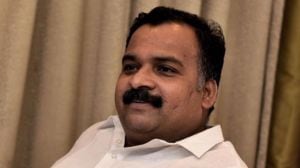Checking out the new guys
Still fresh into the exercise of power, the BJP government receives today a high-profile delegation from Washington that understands well th...

Still fresh into the exercise of power, the BJP government receives today a high-profile delegation from Washington that understands well the need to early establish lines of communication which clearly spell out its agenda for the new century: a free trading world with little or no tariff, where power is concentrated in the hands of the openly nuclear-capable states 8212; and no one else possesses the ability to challenge that hierarchy.
US president Bill Clinton8217;s personal envoy Bill Richardson will, therefore, over the next 24 hours, try and establish how far the new players in New Delhi will go when they talk about 8220;exercising the option to induct nuclear weapons8221; into India8217;s armed forces.
8220;The Americans want to see how much steel there is in Vajpayee,8221; defence analysts here feel, pointing out that a number of statements in the last month by senior leaders in the BJP actually point in a direction not indicated in the manifesto.
The most revealing of all these are comments by Defence MinisterGeorge Fernandes, who not only has veritably discarded the BJP8217;s nuclear ambition, but also junked the need for any more tests for the Agni, India8217;s own intermediate-range ballistic missile. Nevertheless, by the weekend, Fernandes seemed to have backtracked considerably, telling a national daily that while the Agni may not need any more tests, he never said it would never begin serial production.
The American team, led by Richardson and assisted by Karl Frederick Inderfurth, the pointperson in the US State department for South Asia and Bruce Riedel, senior director in the US National Security Council, will be meeting Fernandes and other ministers in an attempt 8220;to get to know them better.8221; Whatever Fernandes8217; own views on India8217;s felt need to go nuclear, human rights violations in Myanmar and Tibet 8212; interestingly, the Americans may find themselves endearingly close to him on the two latter counts 8212; Washington is clearly uncomfortable with this old firebrand Socialist who openly wears his what the UScan do, India can do better8217; heart on his sleeve.
The US trip, of course, is to clearly drive home the message that it intends to retain its place as the Old Faithful at least for some nations in South Asia8217;s chequerboard of historical rivalry. So, Inderfurth, briefing reporters in Washington on the trip last week, said Richardson would be 8220;making a very, very strong effort to encourage and support a resumption of the Indo-Pak dialogue8221; both with Vajpayee and Pakistani prime minister Nawaz Sharif.
With the shadow of Pakistan8217;s Ghauri8217; missile looming large over the impending trip, Inderfurth added, 8220;We will also, of course, raise our concerns8230;about further nuclear and missile developments8230;So we are hopeful that the two governments will show restraint.8221;
A former journalist, Inderfurth couldn8217;t be more blunt about the role his government saw for itself in South Asia: 8220;We want to see these talks, which have been suspended now for some time8230; resumed, now that governments are in place8230;We havesaid that we have no intention of being a mediator of the Kashmir dispute. But we are going to encourage them to move forward on all the areas of contention8230;8221;
The foreign office here, used to this double-edged rhetoric for years, is not saying a word, but some analysts did not hide their concern: 8220;The US wants to ensure that its role as a third-party in the Indo-Pak dialogue doesn8217;t disappear, even though we8217;ve told them again and again that the Islamabad-New Delhi dispute is a bilateral one.8221;
These analysts pointed out that the US, not comfortable with India8217;s nuclear threshold status, wanted to defang New Delhi, so that its 8220;radius for power projection8221; could be limited to South Asia. Any forays into Afghanistan for example, or the Persian Gulf or Central Asia, would then be met by a curt slap on the wrists.
Unless of course, other strategic experts said, New Delhi decided that it was ready to play ball with Washington. Picking up from the everready 8220;oldest democracy-largest democracy8221; cue,the BJP government could well enact over the next couple of years an elaborately staged nuclear charade, which may at some point culminate in the grandest bargain of all time: giving up a decaying, 24-year-old nuclear option in return for the status and recognition of a newly arrived state, full of promise and energy. To call this a 8220;deal8221; would be crass, but if it could be imbued with the effort of fulfillment 8212; especially if the BJP Task Force took its own time to undertake a Strategic Defence Review 8212; the months spent in 8220;strategising8221; might be worth it.
Inderfurth at the Washington briefing resolutely denied the US would be 8220;taking any quid pro quo8221;, not even in nuclear exchange for a permanent Security Council seat for India. He nevertheless conceded that the 8220;Indian government has very strong views on this issue8221; but would not admit that the US had begun to look beyond Germany and Japan.
Interestingly, it doesn8217;t seem as if the government is today keen on exercising such a bargain. The BJPrealises that Washington would be willing to overlook its 8220;fundamentalist8221; image if it keeps the economy open for foreign investors. The government hopes that once these investors are hooked onto the huge profit margins of the Indian market, it will earn for itself the freedom to experiment with most things 8212; including the bomb.
The problem, however, is the time it takes for the nation to traverse that distance, and whether by the end of the journey India would still also care about the moral high ground. That8217;s why the Richardson trip is a landmark: it marks the beginning of a self-discovery whose story could have many endings.
- 01
- 02
- 03
- 04
- 05































